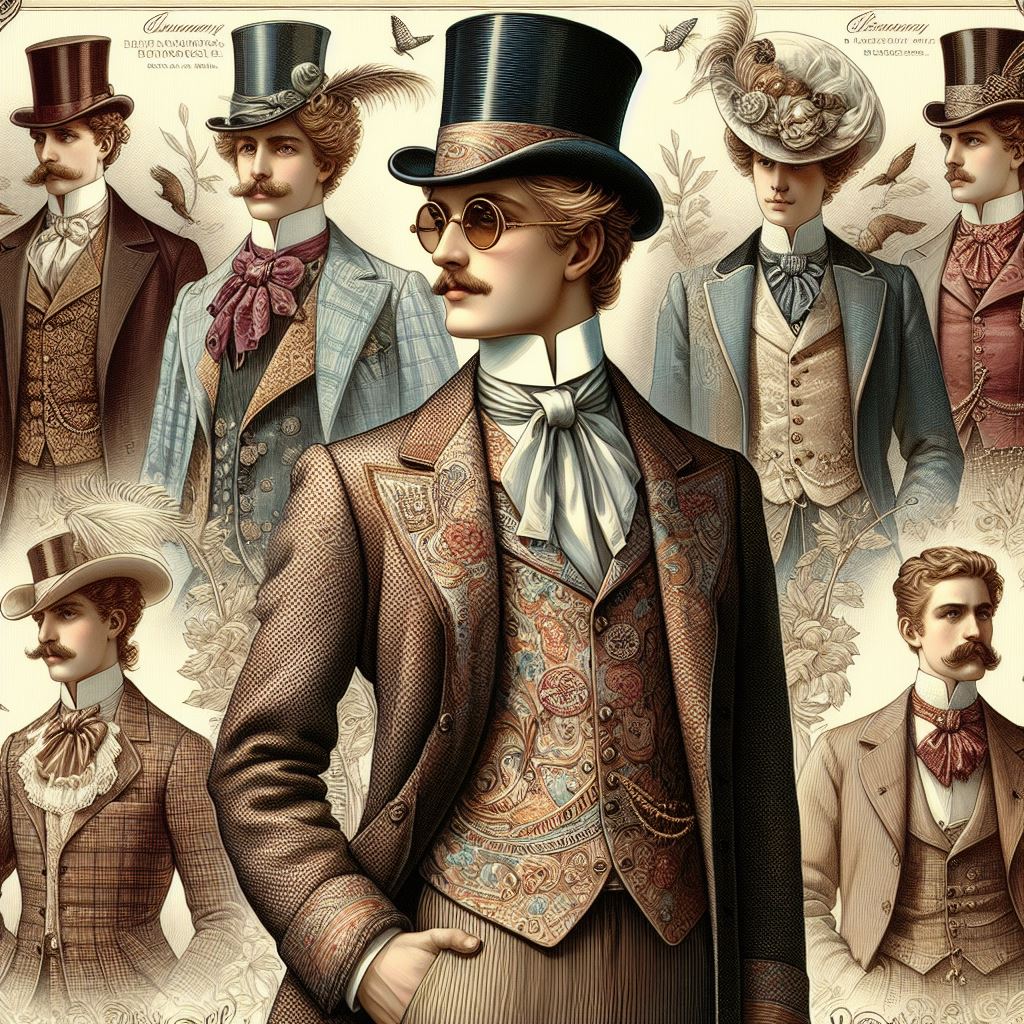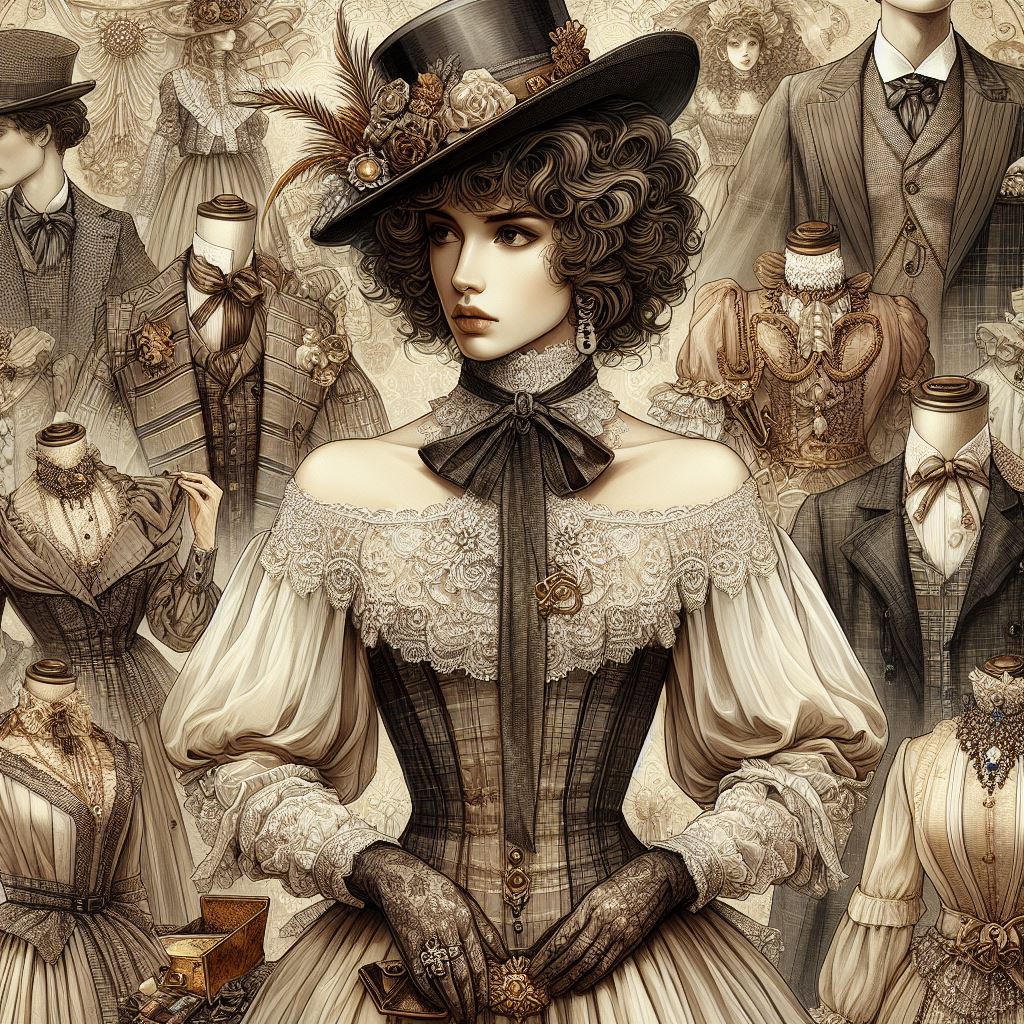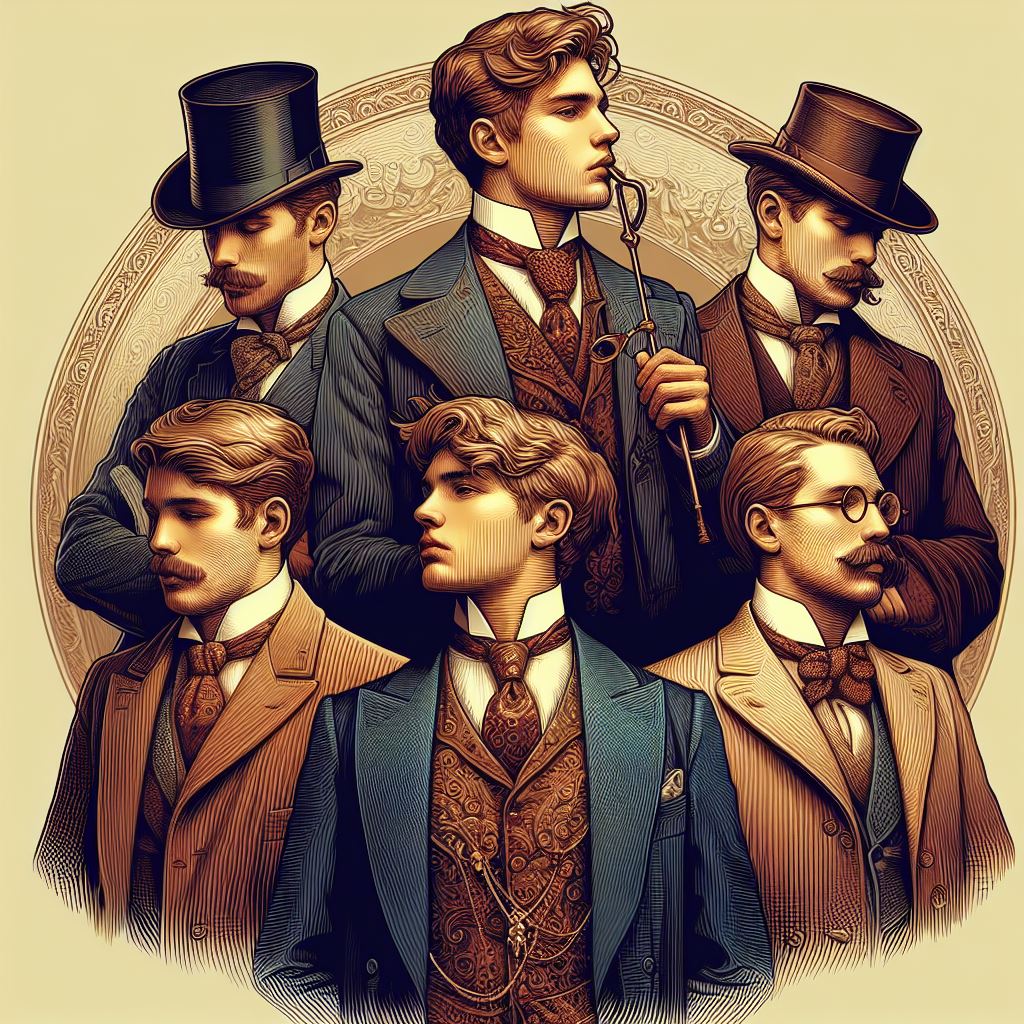Table of Contents
Introduction
The Victorian era in England, spanning from 1837 to 1901, unfolded a distinctive narrative in men’s fashion, echoing the shifts in social, economic, and cultural dynamics. Characterized by formality and symmetry in its early years, Victorian fashion gradually embraced a more relaxed demeanor and a richer color palette as the era advanced. Accessories held a pivotal role, contributing to the overall refinement of men’s clothing. Beyond mere style, the Victorian man’s wardrobe became a reflection of the intricate societal changes occurring during this transformative period. From the structured and subdued early fashions to the vibrant and casual late Victorian styles, this epoch continues to exert a lasting influence on contemporary fashion, embodying a timeless aesthetic born from a dynamic historical backdrop.
Early victorian era
Exploring the intricate tapestry of Victorian men’s fashion in England unveils a captivating journey through three distinctive phases. The early Victorian era, from 1837 to 1860, ushered in formal and symmetrical styles, with the “coat and vest” ensemble dominating the scene—a harmonious blend of dark, somber coats and vibrant waistcoats.
Mid victorian era
Transitioning into the mid-Victorian era, spanning 1860 to 1880, men’s fashion witnessed a subtle evolution. The rise of double-breasted coats and a shift towards subdued colors marked this era. The emergence of the “lounge suit,” crafted from tweed or flannel, added a touch of informality, suitable for leisure or home settings.
Late victorian era
In the late Victorian era (1880-1901), the sartorial landscape continued to evolve. The popularity of the “lounge suit” soared, accompanied by a resurgence of brighter and more varied colors. The introduction of the “sack coat,” characterized by its loose fit and high waist, became a distinctive feature, often complemented by a bowler hat and striped trousers.
Beyond these prominent trends, accessories played a pivotal role in Victorian men’s fashion. Cravats, pocket watches, and walking sticks were cherished embellishments that reflected one’s social status and taste. The transformative journey of men’s attire mirrored broader societal changes, encapsulating shifts in wealth, power dynamics, and evolving social norms.
As we embrace the 21st century, echoes of the Victorian era resonate in contemporary fashion. The enduring appeal of the classic “coat and vest” ensemble and the timeless charm of the “lounge suit” showcase the enduring influence of Victorian aesthetics. Each outfit in this bygone era was a unique expression of individuality, emphasizing that fashion is a dynamic reflection of societal nuances.
Decoding Victorian Elegance: Men’s Fashion in England

Neckwear Extravaganza:
The Victorian era flaunted a dizzying array of cravats, neckties, and bowties. Early Victorian gents showcased intricate cravat styles, while their late-era counterparts opted for a sleek bowtie, adding a dash of sophistication to every look.
Frock Coats: Dapper Details:
Frock coats stole the spotlight, reigning supreme in Victorian fashion. These knee-length wonders bedecked with velvet collars and decorative buttons, were the go-to choice for a gentleman looking to make a style statement.
Headwear Duality: Top Hats vs. Bowlers:
The battle of headwear unfolded with top hats dominating early and mid-Victorian elegance, symbolizing formality and status. Enter the bowler hat in the late era, a casual yet distinguished accessory, often paired with the trendy “sack coat.”
Trousers Evolution:
From knee-length breeches in the early Victorian era to full-length trousers in the late era, the transition spoke volumes about changing attitudes. Striped trousers, particularly with a sack coat, became the quintessential late Victorian look.
Waistcoats: Dapper and Dandy:
Waistcoats remained a steadfast companion throughout the Victorian journey, transforming in design and fabric. Brightly colored contrasts in the early era, muted tones in the mid-Victorian era, and a vibrant revival in the late era marked their sartorial evolution.
Accessories Unleashed:
Victorian men’s fashion wasn’t just about clothes—it was a canvas for accessories. Pocket watches on intricate chains, walking sticks, and gloves weren’t just functional; they were statements reflecting social standing and personal flair.
Military Chic:
Mid-Victorian style embraced military flair with braiding and frogging, inspired by the Crimean War’s impact. This infusion of military aesthetics added a bold touch to formal wear, showcasing the era’s dynamic influences.
Elegance After Dark: Formal Evening Wear:
As evening events gained momentum, so did formal evening wear. Think tuxedo vibes with tailcoats, starched white shirts, and bowties—this “evening dress” or “white tie” ensemble exuded timeless elegance for special occasions.
Fabric Finesse and Pattern Play:
From heavy wool and silks in the early era to breathable tweed and flannel later on, Victorian fabrics told a story. Patterns, ranging from subtle checks to bold plaids, added depth and character to the fashion narrative.
In the intricate dance of Victorian men’s fashion, each element wove a story of transformation, refinement, and meticulous dressing. Step into the elegance of an era that embraced style as an art form.
Social Class Influence on Victorian-Era Fashion
Social class exerted a profound influence on men’s fashion choices in the Victorian era. The upper class favored opulent and expensive attire, while the working class leaned towards simpler and pragmatic clothing.
Fashion and Social Class Dynamics
Fashion in the Victorian era was intricately intertwined with social class distinctions. The affluent upper class could indulge in luxurious materials and elaborate designs, whereas the working class, constrained by limited resources, opted for more straightforward and functional garments.
The Impact of Social Class on Victorian Fashion Trends
The impact of social class on Victorian-era fashion extended beyond clothing choices. It dictated the quality of materials used, the complexity of designs, and the selection of accessories. Additionally, social class influenced the mannerisms of men, with the upper class often adopting a more refined and elegant posture.
Shaping Trends: Queen Victoria’s Impact on Men’s Fashion

Queen Victoria’s affinity for darker tones—such as black, navy, and dark green—set a lasting trend embraced by men during her reign. These sophisticated colors, synonymous with dignity, permeated men’s suits, waistcoats, and accessories, a testament to the Queen’s distinctive taste.
Her commitment to conservative styles reverberated through the fashion of the era. Prioritizing modesty and propriety, Queen Victoria’s influence resonated in the simplicity and absence of extravagance defining men’s attire in the Victorian period. The prevailing fashion ethos mirrored the Queen’s dedication to a refined and restrained aesthetic, leaving an enduring imprint on the style narrative.
Victorian Fashion’s Enduring Impact on Contemporary Men’s Style
The Victorian era has left a lasting imprint on men’s fashion, evident in the continued presence of iconic elements like the two-piece suit and the bowler hat in modern attire. These classic features, known for their simplicity and practicality, remain staples in many men’s wardrobes today.
Timeless Appeal of the Two-Piece Suit and Bowler Hat
The two-piece suit and the bowler hat, synonymous with Victorian fashion, have transcended eras to maintain their relevance. The enduring simplicity and functionality of the two-piece suit make it a perennial favorite, while the bowler hat, though less common, is still recognized as a symbol of Victorian style.
Evolution in Men’s Suiting During the Victorian Era
The Victorian era witnessed a notable transformation in men’s suits, with the conventional three-piece ensemble, comprising a waistcoat, trousers, and frock coat, giving way to the more streamlined two-piece suit. This updated style featured a waistcoat paired with a single-breasted jacket, gaining popularity across different social classes.
Shift from Three-Piece to Two-Piece Suits
The shift from the traditional three-piece suit deemed outdated and impractical with its inclusion of a waistcoat, trousers, and frock coat, marked a pivotal moment in Victorian men’s fashion. The emergence of the contemporary two-piece suit, characterized by a waistcoat and single-breasted jacket, represented a more modern and practical approach to dressing.
Practical Advantages of the Two-Piece Suit
The two-piece suit brought forth practicality and comfort, contrasting with the perceived limitations of the three-piece counterpart. Its ease of movement made it a favored choice for men engaged in various activities. Additionally, the elimination of a separate frock coat enhanced convenience, solidifying the two-piece suit as a more functional and accessible option for men of the era
Victorian Fashion’s Ongoing Influence on Contemporary Dressing
The impact of Victorian fashion extends beyond specific garments, shaping the ethos of modern men’s fashion. The Victorian emphasis on practicality and class distinction in design continues to guide contemporary dressing. Today’s designers frequently draw inspiration from Victorian aesthetics, infusing timeless elements into their creations for a sophisticated and enduring appeal.
Conclusion
Exploring Victorian men’s fashion in England unveils a nuanced portrayal of the era’s societal norms and values. In this pivotal period, we witnessed significant shifts and evolving trends, where the interplay of formality and simplicity defined the sartorial landscape, mirroring a society in transition. Beyond a mere reflection of clothing styles, Victorian fashion emerges as a tangible expression of the cultural changes underway during that time. It becomes evident that the enduring impact of this historical era resonates in modern men’s fashion, as elements such as darker hues and conservative styles persist, serving as poignant reminders that the echoes of the past continue to shape our contemporary aesthetic sensibilities.
FAQs
What did Victorian-era men wear?
To appear sensible and modest, Victorian men commonly opted for plain clothing, predominantly in black, navy, or dark grey hues. The knee-length frock coats, with their overlapping fronts when buttoned, were a staple. Additionally, Victorian men embraced checked or striped trousers and waistcoats to infuse a hint of color into their outfits.
What did rich men wear in the Victorian era?
Affluent Victorian men adorned themselves in suits featuring waistcoats, reserving bowler hats for everyday outdoor occasions and donning top hats for special events. The inclusion of a pocket watch was a common accessory. Meanwhile, affluent women of the era embraced corsets beneath their dresses as part of their fashionable attire.
What did men wear to bed in the Victorian era?
As per insights from “How to be a Victorian,” male undergarments during that era commonly included long cotton or wool drawers paired with a long undershirt featuring extended sleeves. For bedtime purposes, an alternative to the undershirt was a long nightshirt.
